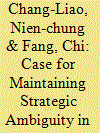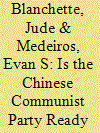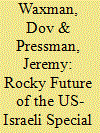|
|
|
Sort Order |
|
|
|
Items / Page
|
|
|
|
|
|
|
| Srl | Item |
| 1 |
ID:
179178


|
|
|
|
|
| Summary/Abstract |
For decades, one key dimension of US policy toward Taiwan has been “strategic ambiguity.”1 With its equivocal reassurance in defending Taiwan, while recognizing there is “one China,” Washington has sought both to prevent Beijing from launching an unprovoked attack on the island and to dissuade Taipei from declaring the island’s de jure independence from the mainland. Since Washington established diplomatic ties with the PRC in 1979, this policy has allowed the United States to maintain cooperative and beneficial relationships with both sides of the Taiwan Strait, contributing to peace and prosperity in the region.
|
|
|
|
|
|
|
|
|
|
|
|
|
|
|
|
| 2 |
ID:
179179


|
|
|
|
|
| Summary/Abstract |
China’s economy has doubled in size every eight years since 1979, making it over 32 times bigger now then it was then and the second largest in the world today.1 Four decades of growth have ushered more than 400 million people in China into the global middle class.2 According to the World Bank, China is currently an upper middle-income country. The country is the only major economy on earth to report growth in 2020 in the wake of the coronavirus pandemic.3 What are the prospects for China to continue its spectacular economic rise and become a high-income country? In this article, we aim to draw attention to an underappreciated factor that we believe may complicate China’s continued economic ascent: hundreds of millions of poorly educated, increasingly underemployed workers hailing from China’s rural hinterland.
|
|
|
|
|
|
|
|
|
|
|
|
|
|
|
|
| 3 |
ID:
179188


|
|
|
|
|
| Summary/Abstract |
Warning signs that nuclear weapons could become a key component of US-China competition have appeared in the last two years, after those weapons have remained firmly in the background of the relationship for decades. On October 1, 2019, China showcased a series of sophisticated nuclear missiles as the finale to its military parade commemorating the 70th anniversary of the founding of the People’s Republic. In April 2020, the United States insisted on Chinese participation in trilateral negotiations with Russia about a future nuclear arms control agreement. Chinese officials flatly refused to participate.1 In May 2020, an op-ed by the editor of the Global Times, a Chinese tabloid known for its hardline, nationalistic editorial line, called for China to increase its arsenal size.2 US officials seized on the op-ed as evidence that China was planning a sprint to nuclear parity with the United States and Russia.3 In China, the op-ed sparked public debate and a vocal defense of the adequacy of China’s small arsenal by a recently retired Chinese People’s Liberation Army (PLA) nuclear researcher.
|
|
|
|
|
|
|
|
|
|
|
|
|
|
|
|
| 4 |
ID:
179175


|
|
|
|
|
| Summary/Abstract |
As the Chinese Communist Party (CCP) prepares to commemorate on July 1 the 100th anniversary of its founding in 1921, it continues to confound policymakers and scholars with its expanding illiberalism amid persistent resilience, defying expectations of eventual moderation and inevitable collapse. From the vantage point of 2021, the CCP has demonstrated that it can adapt to both new and legacy challenges or, at a minimum, find creative ways to kick the can down the road. Not only is the Party resilient, it is also successful: today’s Communist Party controls more wealth, commands a more powerful military force, and can exert its influence over farther reaches of the globe than at any other point in its history.
|
|
|
|
|
|
|
|
|
|
|
|
|
|
|
|
| 5 |
ID:
179189


|
|
|
|
|
| Summary/Abstract |
The Biden administration has a full plate when it comes to nuclear challenges. As of this writing, Iran’s nuclear program is expanding, and the amount of time Tehran would need to produce enough material for a bomb is shrinking.1 Even if a diplomatic solution can be found, Iran is likely to retain a latent capability to build nuclear weapons for the foreseeable future. North Korea’s qualitative and quantitative improvements to its nuclear arsenal—including missiles that can reach the United States—mean that it can no longer be considered a minor nuclear nuisance.2 Evidence suggests that the administration will focus closely on these threats.3 And it would be right to do so.
|
|
|
|
|
|
|
|
|
|
|
|
|
|
|
|
| 6 |
ID:
179183


|
|
|
|
|
| Summary/Abstract |
With its March 2021 Interim National Security Strategic Guidance, the Biden administration set down its first markers on nuclear policy. On international nuclear diplomacy, it committed to “head off costly arms races and re-establish our credibility as a leader in arms control,” “pursue new arms control arrangements” “where possible,” “engage in meaningful dialogue with Russia and China on a range of emerging military technological developments that implicate strategic stability,” and “renew” US leadership of international nonproliferation diplomacy. This was in the context of a commitment “to elevate diplomacy as our tool of first resort.”1 On deterrence strategy, the administration committed to “reduce the role of nuclear weapons in our national security strategy, while ensuring our strategic deterrent remains safe, secure, and effective and that our extended deterrence commitments to our allies remain strong and credible.”2 This was in the context of commitments “to reinvigorate and modernize our alliances” and “to make smart and disciplined choices regarding our national defense.
|
|
|
|
|
|
|
|
|
|
|
|
|
|
|
|
| 7 |
ID:
179186


|
|
|
|
|
| Summary/Abstract |
One of the Biden administration’s top foreign policy challenges is to reinvigorate US alliances. Regional threats in Eastern Europe and Northeast Asia have become more complex in recent years, just as President Trump hastened allies’ and partners’ doubts about US security commitments. It is tempting for officials in Washington and in allied capitals to think or hope that increasing the salience of nuclear deterrence can help to meet the challenges of deterring growing threats and assuring nervous allies. This temptation is especially pertinent in Northeast Asia, which lacks the multi-party alliance and nuclear sharing structures institutionalized in Europe through the North Atlantic Treaty Organization (NATO).
|
|
|
|
|
|
|
|
|
|
|
|
|
|
|
|
| 8 |
ID:
179180


|
|
|
|
|
| Summary/Abstract |
After four harmonious years of US-Israeli relations, during which the Trump administration was closely aligned with the Israeli government led by Prime Minister Benjamin Netanyahu, the US-Israeli relationship is bound to come under strain during the next four years of Joe Biden’s presidency. Although President Biden himself has always been a strong supporter of Israel since his early days in the US Senate, his administration’s policies and preferences will almost certainly differ substantially from those favored by the Israeli government—whether it is led by Netanyahu or Naftali Bennett (who is farther to the right than Netanyahu).
|
|
|
|
|
|
|
|
|
|
|
|
|
|
|
|
| 9 |
ID:
179177


|
|
|
|
|
| Summary/Abstract |
Former President Donald Trump was the first US president to bring the US-China conflict into the open. His successor, President Joe Biden, has consistently indicated that the rift between the two countries can no longer be closed. The tone of the Biden administration’s Interim National Security Strategic Guidance, released on March 3, 2021, suggests that, differences in rhetoric aside, little distinguishes the new administration’s position on China from that of the Trump administration.1 Meanwhile, there has been no change in behavior on the part of China since the Biden administration took office. As the US-China rift is essentially the result of a “Thucydides trap,” the lack of dramatic change in US-China relations with the incoming administration comes as no surprise. However, even if the conflict between the United States and China is inevitable, we cannot sit back and watch as tensions escalate, for there is no doubt that any zero-sum competition between the two global powers would undermine peace and prosperity in East Asia and throughout the world.
|
|
|
|
|
|
|
|
|
|
|
|
|
|
|
|
| 10 |
ID:
179182


|
|
|
|
|
| Summary/Abstract |
Since the early 2000s, Zimbabwe has been under sanctions imposed by the United States and the European Union that have shaped Zimbabwe’s domestic politics as well as the country’s relations with Western nations. The Zimbabwean government under President Emmerson Mnangagwa, who was inaugurated on November 24, 2017, blames the sanctions for the country’s economic meltdown—Zimbabwe is currently facing foreign currency and cash shortages, an inflation rate of 288.5 percent from October 2018 to October 2019, and excessive utility costs and low wages resulting in drastically decreased demand for goods and services. Most citizens are now subjected to extreme poverty.1 The Zimbabwean government has made multiple attempts to rally anti-sanctions sentiment, but sanctions have largely been maintained.
|
|
|
|
|
|
|
|
|
|
|
|
|
|
|
|
|
|
|
|
|